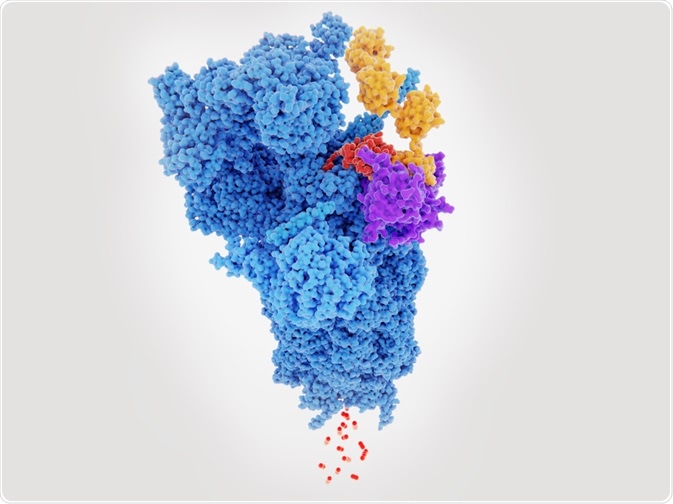Proteolysis describes the breakdown of proteins into smaller units, such as polypeptides or amino acids.

Image Credit: Juan Gaertner/Shutterstock.com
It is a vital process in humans and animals that serves, usually, to activate a cellular protein or switch it off by impairing its functionality.
This helps the body maintain several essential functions related to anything from cell structure, regulation of various bodily processes, the transportation of substances across membranes around the body, to enabling cells to access sources of energy and activating the immune system.
In addition to supporting numerous vital bodily functions and regulating protein breakdown, proteolysis has been found to play a key role in some diseases. It has also proven itself useful in the chemistry of food processing, as well as stain removal.
Below, the process of proteolysis is described in detail. Following this, the functions of proteolysis are explored, and finally, we dive into how abnormal proteolytic activity can lead to disease and illness.
How proteolysis works
Proteolysis is a regulated system that initiates irreversible changes in a protein's structure, the function of which depends on the protein and the context. The process relies on the cleavage of the protein into polypeptides or amino acids.
Without the active process of proteolysis, the hydrolysis of peptide bonds may take hundreds of years. However, the body has evolved an efficient system of protein deconstruction mostly using cellular enzymes called proteases as catalysts.
There are several distinct stages involved in proteolysis that happen in succession. Stage one sees the specific protease groups of calpains and cathepsins breaking down myofibrillar proteins into smaller protein fragments and polypeptides.
During the next stage, these polypeptides and protein fragments are hydrolyzed by di- and tri-peptidylpeptidases, generating even smaller peptides. The last stage is where free amino acids are created as products of the action of aminopeptidases, dipeptidases, and carboxypeptidases on the small peptides.
Functions of proteolysis
The changes that the proteins go through during proteolysis are irreversible and impact on the protein’s functionality by changing its structure.
These changes impact intracellular and extracellular signaling, having the effect of initiating certain bodily processes depending on the protein that was broken down. Proteolysis is implicated in digestion, cell cycle regulation, apoptosis (regulated cell death), and more.
More recent studies have implicated the role of proteolysis in more complex processes, such as learning and memory through the governance of synaptic plasticity.
The main, overarching function of proteolysis is to break down the protein molecules from the food that we eat into smaller amino acids that can be used by the body. The process is also required for the production of active proteins from synthesized polypeptide chains.
Mostly, the role of proteolysis falls into one of three categories, the first being to regulate a physiological process, the second being to oversee a cellular process, and finally, the last role of proteolysis is to breakdown accumulated or abnormal proteins within a cell.
Studying proteolysis is useful for growing our understanding of how these processes work, and how dysfunction at any stage can impact the host. Proteolysis has also become important to chemists in the food industry as well as to chemists developing stain removal products.
This is because the breakdown of proteins is key to both these industries, and understanding the process of breaking down specific proteins can lead to the development of new products that meet specific desired criteria.
Finally, proteolysis has established itself as a useful tool for analyzing and studying proteins in laboratory settings, helping to grow our knowledge of the biological function of specific proteins, opening the doors to new applications in various industries.
Disease and proteolysis
The dis-regulation of proteolysis is influential in the initiation of some diseases. It is also a technique used by some venoms.
Neurodegenerative diseases, such as Alzheimer’s disease and Parkinson's disease, are related to protein aggregation, where misfolded proteins build up and clump together either intra- or extracellularly. Unsurprisingly, this process is linked with abnormal proteolysis functioning.
Also, chronic inflammatory diseases are related to abnormal proteolysis. Diseases such as rheumatoid arthritis are thought to be related to the abnormal release of enzymes into extracellular space, having the impact of breaking down the tissue surrounding the lysosome.
Research has shown that several other diseases are also associated with abnormal proteolytic activity, such as pancreatitis, which is related to the premature release of proteases in the pancreas, and diabetes mellitus, which is suspected to be in part related to abnormally high degradation of certain proteins.
Summary
Proteolysis is the breakdown of proteins into smaller polypeptides or amino acids. Research has shown that this process is key to many vital functions of the human body, which has made the study of this process incredibly significant.
Further to this, proteolysis has been implicated in various diseases, making the increasing knowledge base surrounding the workings of proteolysis essential to future developments in diagnosis and treatment.
Sources:
- Barrett, A. (1992). Cellular Proteolysis An Overview. Annals of the New York Academy of Sciences, 674(1 Proteases and), pp.1-15. https://www.ncbi.nlm.nih.gov/pubmed/1288356
- Bradbury, J. (2001). Proteolysis problems implicated in neurodegenerative diseases. The Lancet, 357(9269), p.1679. https://www.thelancet.com/journals/lancet/article/PIIS0140-6736(00)04866-2/fulltext
- Hegde, A. (2008). Proteolysis and Synaptic Plasticity. Learning and Memory: A Comprehensive Reference, pp.525-545. https://www.sciencedirect.com/science/article/pii/B9780123705099001960
- Varshavsky, A. (2001). Proteolysis. Encyclopedia of Genetics, pp.1573-1575. https://www.sciencedirect.com/science/article/pii/B0122270800010417
Further Reading